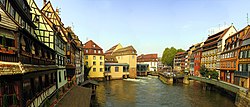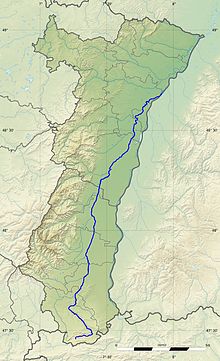Ill (France)
The Ill[N 1] is a river in France. It flows through the plain of Alsace. It is an important left tributary of the Rhine river. It is the main river of Alsace. It flows through the Haut-Rhin and the Bas-Rhin departments in the Grand Est region.
| Ill | |
|---|---|
 The Ill in the Petite France quarter of Strasbourg. The river's only lock can be seen right of centre. | |
 | |
| Location | |
| Country | France |
| Region | Grand Est |
| Physical characteristics | |
| Source | |
| - location | Jura mountains |
| - elevation | 570 m (1,870 ft) |
| Mouth | |
| - location | Rhine |
| - coordinates | 48°42′1″N 7°55′52″E / 48.70028°N 7.93111°E |
| Length | 217 km (135 mi) |
| Basin size | 4,760 km2 (1,840 sq mi) |
| Basin features | |
| Progression | Rhine→ North Sea |
| Tributaries | |
| - left | Aar, Bruche, Doller, Souffel, Thur |
Geography
changeThe Ill river is 216.7 kilometres (134.7 miles) long. Its drainage basin has an area of 4,760 square kilometres (1,838 square miles).[1]
Course
changeThe Ill starts in the northern side of the Glaserberg mountain, in the Jura Mountains near the Swiss border, in the commune of Winkel, (Haut-Rhin department), at an altitude of about 560 metres (1,837 feet).[2] From here, the Ill flows first to the east to Ferrette and to Illfurth where it is joined by the Largue river, the main right tributary of the Ill.
From Illfurth, the Ill runs northward through Alsace, flowing parallel to the Rhine river.
The Ill river flows within the Grand Est region, 2 departments and 70 communes. It flows through the following communes, among others:[1]
- Haut-Rhin : Illfurth, Frœningen, Hochstatt, Zillisheim, Brunstatt-Didenheim, Mulhouse, Bourtzwiller, Illzach, Sausheim, Ruelisheim, Ensisheim, réguisheim, Meyenheim, Oberentzen, Niederentzen, Biltzheim, Oberhergheim, Niederhergheim, Sainte-Croix-en-Plaine, Logelheim, Sundhoffen, Andolsheim, Horbourg-Wihr, Colmar, Illhaeusern
- Bas-Rhin : Sélestat, Ebersmunster, Kogenheim, Sermersheim, Huttenheim, Benfeld, Matzenheim, Osthouse, Erstein, Nordhouse, Hipsheim, Eschau, Illkirch-Graffenstaden, Ostwald, Strasbourg, Offendorf
Five communes in the Alsace have their names from the riverː
Finally, the Ill river flows into the Rhine river in the commune of Offendorf, just to the north of Strasbourg.[3]
Main tributaries
changeThe main tributaries of the Ill river are all left tributaries; the right tributaries are very short streams. Only the Largue starts in the Jura Mountains; the rest have their sources in the Vosgues mountains, to the east.[1]
- Largue - 50.5 kilometres (31.4 miles)
- Doller - 46.5 kilometres (28.9 miles)
- Thur - 53.3 kilometres (33.1 miles)
- Lauch - 50 kilometres (31 miles)
- Fecht - 49 kilometres (30 miles)
- Giessen - 33.6 kilometres (20.9 miles)
- Andlau - 42 kilometres (26 miles)
- Ehn - 36.5 kilometres (22.7 miles)
- Bruche - 76.7 kilometres (47.7 miles)
Hydrology
changeIts average yearly discharge (volume of water which passes through a section of the river per unit of time) is 59.70 cubic metres per second (2,108 cubic feet per second) at Strasbourg in the Bas-Rhin department, for the period 1974 - 2017.[4]
Average monthly discharge (m3/s) at Strasbourg (1974 - 2017)[4]

Gallery
change-
The Ill in Sélestat.
-
The Ill and the St Paul's church in Strasbourg.
-
The Ill in Strasbourg.
Related pages
changeNotes
changeReferences
change- ↑ 1.0 1.1 1.2 "L'Ill (A---0030)" (in French). SANDRE - Portail national d'accès aux référentiels sur l'eau. Archived from the original on 3 March 2016. Retrieved 25 December 2017.
- ↑ "Source de l'Ill" (in French). Géoportail. Retrieved 25 December 2017.
- ↑ "Confluence de l'Ill" (in French). Géoportail. Retrieved 25 December 2017.
- ↑ 4.0 4.1 "L'Ill à Strasbourg (Chasseur Froid, La Robertsau)" (in French). Banque Hydro. Archived from the original on 3 March 2016. Retrieved 25 December 2017.